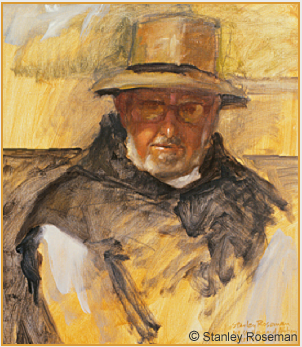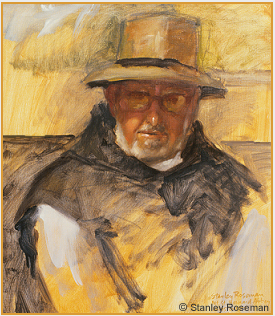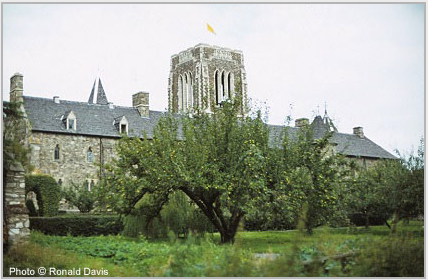

AN ARTIST'S JOURNAL
Edited and prepared for the Internet by Ronald Davis
Remembering the Octogenarian Trappist Monk
Father Benedict
Father Benedict

2. Mount St. Bernard Abbey, Leicestershire.
View from the monastery enclosure, looking towards the orchard
and the main monastery building, with scriptorium
and dormitory (above), the library (far right),
and the church tower beyond.
View from the monastery enclosure, looking towards the orchard
and the main monastery building, with scriptorium
and dormitory (above), the library (far right),
and the church tower beyond.
Abbot Cyril, Prior Luke, Guestmaster Father Mark, and the Community warmly welcomed Roseman and Davis to Mount St. Bernard Abbey. The Trappist monks invited the artist to draw them in church and brought him inside the enclosure to further pursue his work on the monastic life. Writing about his and Davis' sojourns at Mount Saint Bernard Abbey, Roseman warmly remembers Father Benedict, the engaging subject of the artist's superb oil on canvas portrait presented above and below, (fig. 3).
The revival of monasticism in England in the nineteenth century led to the founding in 1835 of Mount St. Bernard Abbey, a member of the branch of Cistercian monasticism called the Order of Cistercians of the Strict Observance, also known as the Trappist Order. Mount St. Bernard Abbey is a large monastic complex with an abbey church, conventual buildings, workshops, greenhouses, orchards, vegetable gardens, and farm buildings to accommodate a dairy herd which provided the monastery's main source of income.
Mount St. Bernard Abbey, secluded in a part of Charnwood Forest in Leicestershire, was the first Trappist monastery where Roseman painted and drew in 1978 at the outset of his work on the monastic life.
"I had seen Father Benedict working in the orchard and vegetable garden, where he wore a straw hat that shaded his fair, rosy complexion. He wore eyeglasses with largish frames and had a closely cropped, white beard. Father Benedict would greet me amicably as I walked to or from the carpentry shop, for the carpenter, Ian, had kindly provided me with wood and tools to build the stretchers for my canvases. Next door to the carpentry shop was the pottery, where I also spent time with the potter, Bernard, with whom I shared an interest in art and architecture.
"Father Benedict had been Prior of Mount St. Bernard Abbey for some twenty-five years. He entered the monastery when he was seventeen, having walked to Mount St. Bernard from his home in a neighboring village. In those days before the Second Vatican Council, as Father Benedict explained to Ronald and me, when a man took his vows to become a Trappist monk, he accepted the strict confines of a cloistered life. Father Benedict further related that he was not permitted to leave the cloister to attend his father's funeral, which took place in the parish cemetery adjacent to the monastery.
"I remember one afternoon when Father Benedict invited Ronald and me to join him for tea. Assuming we took sugar with our tea, Father Benedict handed Ronald the sugar bowl.
'' 'Thank you,' said Ronald. 'I'll take a little.'
" 'Take as much as you want,' replied Father Benedict.
'' 'But I have read that one should not have too much sugar…or none at all. Sugar, they say, is not good for you.'
'' 'I always take enough,' the octogenarian Trappist monk defiantly replied as he added his third heaping spoonful of sugar to his milky tea. 'And I'm still here!'
"In letter from Mark, he writes of work in the orchard: 'At present, there's a massive apple crop ripening up and that will need picking before long. Fr Benedict comes into his own on these occasions.'
Father Benedict,
Portrait of a Trappist Monk, 1978
Mount St. Bernard Abbey, England
Oil on canvas, 80 x 60 cm
Private collection
Portrait of a Trappist Monk, 1978
Mount St. Bernard Abbey, England
Oil on canvas, 80 x 60 cm
Private collection
Ronald's Birthday at Mount St. Bernard Abbey
'Dear Ronald -
You are 33 to-day. Tradition states that Our Divine Lord Jesus Christ
lived 33 years on earth - may His Light ever shine on you,
till you come to HIS ETERNAL LIGHT.
Fr Benedict Glynn' "
You are 33 to-day. Tradition states that Our Divine Lord Jesus Christ
lived 33 years on earth - may His Light ever shine on you,
till you come to HIS ETERNAL LIGHT.
Fr Benedict Glynn' "
"Earlier that day Ronald received a very thoughtful personal birthday card from Father Benedict:
Roseman painted the superb oil on canvas portrait of the eighty-four year-old Scottish monk wearing his gardener's hat, which shades his white-bearded face from the bright summer sun. The artist recounts:
Roseman composed the painting with geometric abstractions in the division of pictorial space and in the depiction of the monk's black scapular over a white tunic and his broad-brimmed hat. Vigorous brushstrokes express Father Benedict's lively personality.
The artist finely renders the face of the Trappist monk with ruddy complexion from hours of work in the orchard and garden. Father Benedict, glancing out from behind eyeglasses, is about to speak a few friendly words.
3. Father Benedict,
Portrait of a Trappist Monk, 1978
Mount St. Bernard Abbey, England
Oil on canvas, 80 x 60 cm
Private collection, Switzerland
Portrait of a Trappist Monk, 1978
Mount St. Bernard Abbey, England
Oil on canvas, 80 x 60 cm
Private collection, Switzerland
Father Benedict, Portrait of a Trappist Monk
"Taking his seat in front of my easel, Father Benedict said, 'This will be a new experience for me. I have never had my portrait painted.'
"Father Benedict brought me upstairs to the second floor of the monastery and onto a balcony outside the monks' dormitory.
" 'It's quiet up here,' he said. 'You won't be disturbed.'
"I went back into the monastery to get a chair for Father Benedict. As I was setting up my easel and canvas and preparing my palette with my oil paints, he left me and returned to the cloister. In a few minutes he was back carrying a chair and announced: 'The artist must be comfortable, too!'
"He asked if he could speak to me while I worked, as he was concerned that he might disturb my concentration, but I was very happy for his conversation because his speaking brought a liveliness to his expression, which I wanted to capture on canvas."
Roseman relates in his journal: "I completed the painting in what is called 'alla prima,' which refers to the layers of oil paint being applied in basically one sitting. I was very grateful to the kindly Trappist monk for having given me his time that afternoon.
"I was putting away my brushes and supplies and closing up my paint box when the church bells began to announce the hour for Vespers. Father Benedict said he admired my monastic sense of timing. He asked, 'Will there be an unveiling of the portrait after supper?'
" 'Yes, of course,' I assured him, and again expressed my sincere gratitude to Father Benedict for giving me the opportunity to paint his portrait.
"After supper, a number of the monks gathered in the spacious room that Mark had thoughtfully provided for Ronald and me. The monks and Ronald and the sitter himself expressed their overwhelming enthusiasm for the portrait, for which I was deeply grateful. As this was my first Trappist monastery at the outset of my work on the monastic life, the appreciation for my work was especially meaningful."
Roseman and Davis kept in touch over the years through correspondence with the monks of Mount St. Bernard Abbey. Father Benedict writes to the artist and his colleague in August 1984:
Correspondence from the Monks
"Delighted to get your very kind and affectionate letter - have very pleasant memories of your visit - always welcome - just had a big celebration - Platinum Jubilee of 70 years being a monk of Mt St Bernard. Will be 91 soon but feel very young about 20. God bless you both."
- Father Benedict Glynn, OCSO
Mount St. Bernard Abbey
Mount St. Bernard Abbey
"It was warming to have your appreciative remarks about your time here. . . . It was an exciting time. Posterity will benefit from your work. . . ."
- Father Mark Hartley, OCSO
Mount St Bernard Abbey
Mount St Bernard Abbey
Father Mark, when he was guestmaster, was greatly encouraging to Roseman in his work, introduced him to members of the Community, and thoughtfully provided the artist with a spare room where he could prepare his canvases and store his paintings. In ongoing correspondence Father Mark writes to Roseman in October 1998:
Included in Roseman's work at Mount St Bernard Abbey is the superb painting Father Ian, Portrait of a Trappist Monk in Meditation, in the collection of the Musée Ingres, Montauban, and presented on the Journal page "Correct Usage of the Word 'Monk' " in reference to Male Members of Religious Orders in the Western Church.
You are cordially invited to visit www.stanleyroseman-monasticlife.com
© Stanley Roseman and Ronald Davis, 2014 - All Rights Reserved
Visual imagery and website content may not be reproduced in any form whatsoever.
Visual imagery and website content may not be reproduced in any form whatsoever.


"At my first Trappist monastery that spring and summer of 1978, I had the memorable experience of a friendship with Father Benedict and painting a portrait of the genial, eighty-four year-old Scotsman with an endearing sense of humor and of great kindness and deep spirituality."
"On May 25th, the date of Ronald's birthday, Father Anselm, the cook, baked Ronald a delicious birthday cake, and the monks signed and inscribed a birthday card to 'Brother Ron.' In appreciation for their thoughtfulness, Ronald offered to prepare a supper of French toast for the Community. Ronald's mother was of French ancestry and prepared French dishes for her family, including French toast. Abbot Cyril was delighted with Ronald's offer and said supper that evening would be a new culinary experience. With the Abbot's permission Ronald took on the responsibility as monastery cook. Anselm and Ian kindly assisted him in the kitchen.
"The monks had plenty of fresh eggs, fresh milk from their dairy farm, and homemade bread. Although the monastery had no maple syrup, which would be expected, Anselm suggested honey as a substitute. Beekeeping is a ancient monastic occupation, and the monks of Mount St. Bernard kept an apiary. The meal that evening was a great success, as I can attest to, for I was invited to take supper in the refectory with the monks. Due to the enthusiasm of the cooks, there was more than enough French toast for everyone to have a second serving, enjoyed by all.
AN ARTIST'S JOURNAL
An Audience with Pope John Paul II
Remembering the Octogenarian Trappist Monk Father Benedict
An Invitation to Draw at the Metropolitan Opera
On Portraiture